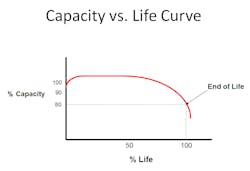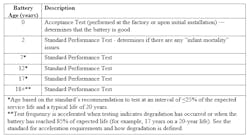Or, more importantly, do you know “how” your batteries are — that is, what’s their condition and can they perform their function if called upon to do so?
As with most things associated with the electrical grid in North America, the batteries tend to be a victim of their own success — they are so reliable that we take them for granted. While there are several types of batteries used to provide back-up power to the control systems in our facilities, most of them are of the vented lead-acid (VLA) type and this article will focus on this type.
VLA batteries have been around for over a century and their premature failure modes are clearly known and have mostly been addressed. Many come with a 20-year warranty and when properly maintained, it’s not unusual for them to last years longer than that before they need to be replaced.
A new VLA battery typically starts out between 90% and 100% of the manufacturer’s rated capacity. Then over the next few years, again, when properly maintained, its capacity will slowly increase before starting to decline. This decline will continue at a relatively slow pace up to about 80% after which it will exponentially increase — this is called the “knee of the curve.” See Figure 2 for the capacity-life curve for a typical VLA battery showing this life cycle. The battery must be replaced when it reaches the 80% point to prevent it from quickly dropping so low as to no longer be able to support its required loads.
If the battery was properly sized, it would have been able to perform its function down to this 80% threshold. See IEEE 485, IEEE Recommended Practice for Sizing Lead-Acid Batteries for Stationary Applications, for the industry standard on VLA battery sizing.
While time consuming and expensive, a performance (discharge) test is the only real way to know the battery’s capacity. While internal ohmic testing can be used to indicate a potential problem with the battery, it cannot determine the battery’s capacity as it does not always measure all of the failure mode issues. These tests can give false negatives (for example, the battery is good but the test shows a problem) and worse, can give false positives (for example, the battery is bad but the test shows no problem).
IEEE 450, IEEE Recommended Practice for Maintenance, Testing, and Replacement of Vented Lead-Acid Batteries for Stationary Applications, is the industry standard for VLA batteries and, as its title indicates, provides the guidelines for how best to maintain, test, and ultimately replace VLA batteries. The recommended performance (capacity) test schedule is shown in Table 1.
Analyzing the results from the above test schedule will allow determining where the battery is on the capacity-life curve and, thereby, when it is likely to need replacement. It will also provide a sense of comfort that the battery will be able to perform its function until the next test.
IEEE 450 also allows using a modified performance test if the “as found” condition of the battery and/or duty cycle requirement testing are desired.
NERC Standard PRC-005 (currently at version 6), Protection System, Automatic Reclosing, and Sudden Pressure Relaying Maintenance, is required for equipment affecting the reliability of the bulk electric system (that is, the transmission "grid") and includes minimum maintenance and testing activities along with maximum intervals for those activities on VLA (Table 1-4a), valve-regulated lead-acid (VRLA) (Table 1-4b), and nickel cadmium (Ni-Cad) (Table 1-4c) batteries.
One of the required activities is to “verify that the station battery can perform as manufactured” which can be done in one of two ways.
One is to conduct “a performance or modified performance capacity test of the entire battery bank” which has to be conducted at a maximum of six calendar years.
The other is by “evaluating cell/unit measurements indicative of battery performance (for example, internal ohmic values or float current) against the station battery baseline” which has to be conducted at a maximum of 18 calendar months. Note that the examples of what these measurements could be (that is, “internal ohmic values or float current”) are just that, examples and the onus is on the battery owner to show that these measurements do, in fact, verify that the station battery can perform as manufactured.
NERC has provided a Supplementary Reference and FAQ document to go along with the standard. This document is a great resource for what is meant by the standard and how to meet the standard’s requirements. Within this document is the following (underlining added by me):
How do I verify the battery string can perform as manufactured?
Optimally, actual battery performance should be verified against the manufacturer’s rating curves. The best practice for evaluating battery performance is via a performance test. However, because of both logistical and system reliability concerns, some protection system owners prefer other methods to determine if a battery can perform as manufactured. There are several battery parameters that can be evaluated to determine if a battery can perform as manufactured.
Ohmic measurements and float current are two examples of parameters that have been reported to assist in determining if a battery string can perform as manufactured.
The evaluation of battery parameters in determining battery health is a complex issue and is not an exact science. This standard gives the user an opportunity to use other measured parameters to determine if the battery can perform as manufactured. It is the responsibility of the protection system owner, however, to maintain a documented process that demonstrates the chosen parameter(s) and associated methodology used to determine if the battery string can perform as manufactured.
As can be clearly seen in the above, particularly with the underlined areas, the standard does not state that internal ohmic values can “definitely” be used to verify that the station battery can perform as manufactured. It also makes it clear that the battery owner must be able to show this for them to be used.
Station backup batteries are expensive to design and install so they wouldn’t be there if they weren’t needed. While they are a great resource that can provide years of reliable service, they cannot be “installed and forgotten” as they must be properly maintained. As such, it is prudent to “pay now” for the proper maintenance rather than “paying later” for a catastrophic event (for example, protective relaying not working and/or a breaker not tripping on a fault condition) because of the battery failing while trying to provide protection for the equipment it was designed to support.


